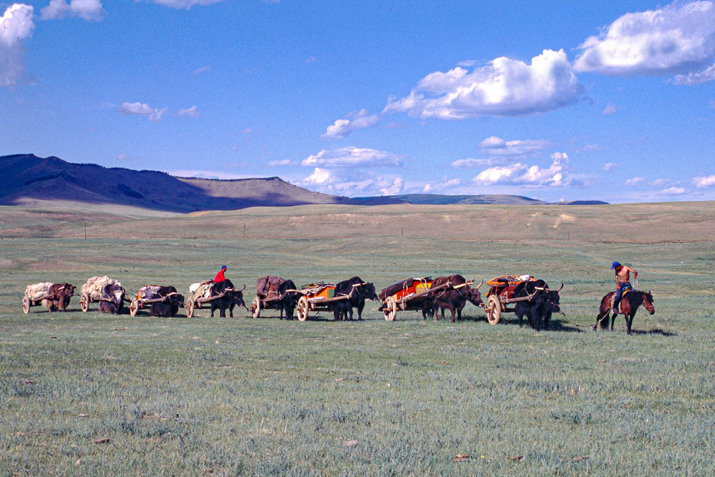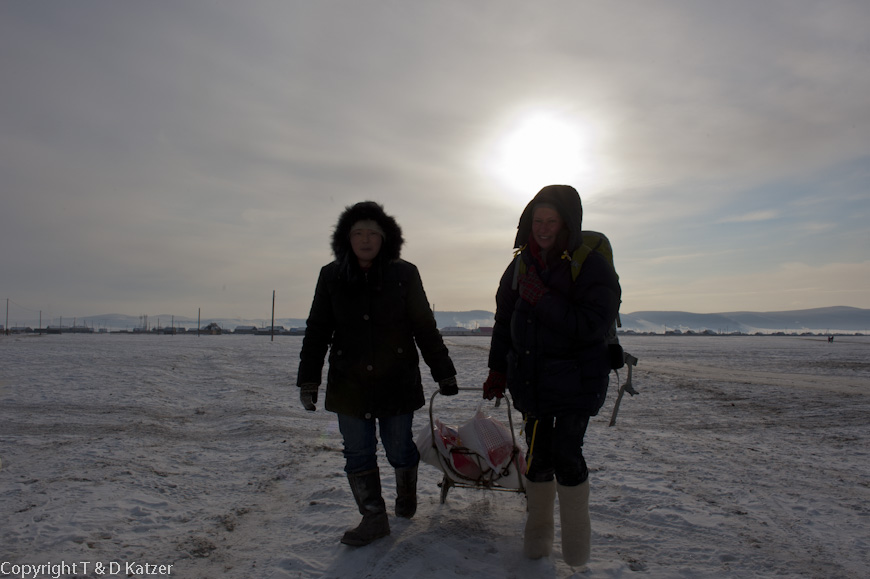
Backing
N 51°21'785'' E 099°21'046''
Day: 133
Sunrise:
09:08
Sunset:
17:16
Total kilometers:
1146
Soil condition:
Ice, snow
Temperature – Day (maximum):
minus 10°C
Temperature – day (minimum):
minus 25°C
Temperature – Night:
minus 34°C
Latitude:
51°21’785”
Longitude:
099°21’046”
Maximum height:
1475 m above sea level

Tanja is out and about every day to buy the food we still need for the winter. As transportation from Mörön to Tsagaan Nuur is expensive, we did not bring flour, noodles, rice and meat with us. Tanja now has to carry these staple foods with great difficulty. Today she is traveling with Tsendmaa. Before she reaches the yurt, she calls me briefly on my cell phone. “We’ll be there in ten minutes. If you want, you can meet us and help us pull,” she says. “I’m in a hurry,” I reply, pulling on two woollen jackets and a windstopper jacket, slipping into my warm Mongolian felt boots and stepping out into the cold. From a distance I can see Tanja and Tsendmaa dragging a rickety, ancient single-axle handcart across the snowfield. “Why did you buy 50 kg of flour? One bag is heavy enough, isn’t it?” I ask Tanja, taking over the pulling. “Tsendmaa’s family also needs flour,” answers Tanja. As we carry the sack of flour over the threshold of the yurt door and place it under the folding table we bought in the furniture store in Mörön, we think about how much flour we should take with us to the taiga. “I think 50 kg should be enough for now. There’s always a four-wheel drive vehicle going to the Tuwa. Tsaya said that it’s not a big problem to get supplies this way,” says Tanja.
In the afternoon, Dalai and Shagai visit us again. As always on such visits, we offer tea and cookies. We talk for a long time about everything and nothing until we finally get to the real reason for the visit. After a few gallant detours, Shagai tells them about valuable stones they find in the taiga. We sell the stones to the Chinese. They’re really keen on it. For one kg we get between 50,000 (€33) and 60,000 tugrik (€34)”. “Which stone is it?” I ask. “Green jade,” answers Shagai with shining eyes. I begin to understand because jade has been used to make small sculptures, weapons and jewelry since the Neolithic Age. These objects were often used as grave goods. The Chinese and Japanese have always valued jade as the most precious of all stones. Vases, bowls, tablets and statues were carved from it, many of which are now museum pieces. Even now, white and green jade is an extremely popular gemstone in China and its processing is one of the most important branches of Chinese arts and crafts.
“And why are you telling us this?” I ask after a pause for thought. “We want to go on a search on December 15th.” “Who are we?” “Eight Tuwa men” “In the middle of winter? Isn’t that difficult because of the snow?” “It hasn’t snowed much yet. So it’s no problem to find the stones,” he replies. As we wanted to leave on the 15th, Tanja and I talk for a while and come to the conclusion that it doesn’t matter whether it takes a few days or not. “When will you be back?” I want to know. “On December 22nd.” “Then we can leave on December 23?” “Yes. Absolutely,” Shagai is pleased with our understanding.
After Shagai and Dalai have left, I call Saraa. “So, did you get through to the mayor?” I ask excitedly. “Yes, and I have good news. I went to see him in person and was immediately granted an audience. He listened to me with great interest and at the end of the conversation, the mayoress of Tsagaan Nuur called immediately. He explained everything to her and asked for her support. The mayor promised to support him. So you don’t need to worry any more. You have the backing of a high authority,” Saraa says excitedly. “That means the Tuwa and the mayor have now agreed. That’s fantastic. Nothing can stop us now. Thank you very much for your efforts,” I say in high spirits.
We look forward to your comments!

